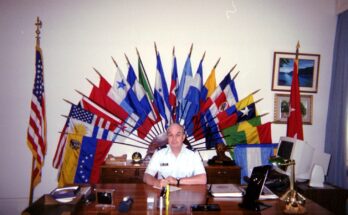The “Concentration Camp” was not a Nazi invention. It was used by the British during the Boer War in South Africa. The British reasoned that if they took the Boer women and kids and concentrated them into prison camps, the Boer men would stop fighting. The camps were abysmal with starvation rations, minimal clothing and shelter, and often brutal treatment. The camps did not work as the Boers continued fighting. Winston Churchill was among those who proposed the concentration camps.
Adolph Hitler established more than a thousand concentration camps and sub-camps before and during WWII. The first was Dachau in 1933. Originally, most camp inmates were Germans – communists, homosexuals, mentally retarded, Gypsies, political prisoners and others who were “inferior”. Later, the prisoners were mostly Jews.
Shamefully, America had its own concentration camps. We established ten of them during WWII. More than 120,000 Japanese were removed from the West Coast to camps as far away as Eastern Arkansas. President Franklin Roosevelt signed Executive Order 9066 on 19 February, 1942 directing their removal. The Japanese were given only a few days’ notice before being taken into custody. Having little time to arrange for the management of their farms, homes, and small businesses, many of them were forced to sell to their White neighbors often for a few cents on the dollar. The fact that they were American citizens did not protect them. They were seen as a threat simply because they had Japanese blood in their veins. Strangely, no Germans were sent to relocation camps even though Germany was a bigger threat to America than Japan. The racial implications were clear.
The loyalty of the Japanese Americans was never seriously questioned. Even with their families confined to relocation camps, thousands of young Japanese men volunteered to serve in the US Army. They were sent to Europe where they served heroically and with distinction.
After the war ended, some of the Japanese families decided to stay in Arkansas. They had grown to appreciate the rich soil and four distinct seasons. They developed prosperous vegetable farms and hauled their products to market in Studebaker pickup trucks.
Two Japanese families relocated to Central Arkansas near my home. The Oishis and the Nakamuras were good neighbors. Although there was no social contact between them and their White neighbors, they were well respected and treated fairly. The Japanese kids excelled in school. Academically and in sports. Two of them were my friends. Tetsumi Oishi was a champion weightlifter and George Nakamura was a star of our basketball team though he had been born without a left hand. The Japanese kids worked on their farms after school and on weekends.
I learned many years later that my two friends had moved to California. They both had earned advanced degrees in engineering and were leaders in the rapidly developing “Silicon Valley”. I don’t believe they ever held any lingering resentment about the way the country of their birth had treated their parents. In 1976, President Gerald Ford issued an apology to the Japanese Americans, noting that their treatment was a “national mistake”. Nothing could atone for the illegal behavior of our own government towards American citizens.
Later, Gerald Ford issued his famous quote, “a government big enough to give you everything you want is big enough to take from you everything you have”.



